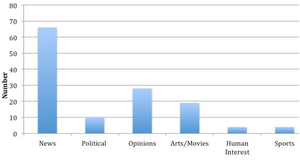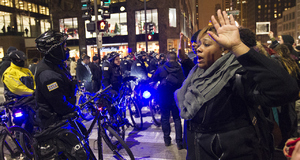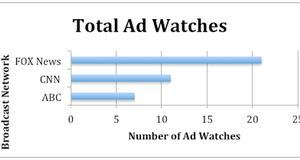From Elon Journal of Undergraduate Research in Communications VOL. 5 NO. 1The Agenda-Setting Potential of Saturday Night LiveMethodologyThe data collected for this study is primarily qualitative, drawing upon other research and literature to further interpret and answer the question presented. Since this research analyzes Saturday Night Live and agenda-setting theory from a historical perspective, and compares the political power of the program beginning nearly 40 years ago, quantitative research is not appropriate or necessarily integral to the study. Rather, anecdotes and theories from previous research are reviewed in order to analyze and synthesize the various components in this discussion. To keep the literature objective, academic writings from both viewpoints were included. Literature providing informative definitions and examples of concepts like political satire and the agenda-setting theory was also referenced to foster a clearer understanding of the ideas behind the argument. To support the claim that Saturday Night Live’s political coverage has a tangible effect on political views, several Gallup poll results were also included. AnalysisThe Definition and Evolution of the Agenda-Setting TheoryBefore discussing whether or not Saturday Night Live truly possesses the power to set the political agenda, the theory of agenda-setting must first be clarified. The current definition of the agenda-setting theory delves into the impact of television programs in impacting viewers’ perceptions of political figures or issues. Programs like “The Daily Show,” “The Colbert Report,” and “Saturday Night Live” do not directly persuade or influence viewers to support a candidate or issue, but instead plant certain ideas and concepts in their minds. (Esralew & Young 339) Esralew and Young also argue that issues spotlighted on television programs are often perceived by viewers as the most important. The authors identify agenda setting as the first step in a two-step process of television’s political influence. The second step, called “priming,” takes place when viewers evaluate political figures according to the program’s positions on the issues or characterizations promoted during the agenda-setting phase. Initial research on the agenda-setting theory began in the late 1960s, and defined the concept simply as the “the relationship between which issues voters considered more important and which issues were most heavily covered by the news media (Weaver 348). Weaver promotes the notion that the media can create a “perceived reality” by airing material about certain candidates or issues. Thus, viewers often turn to television programs for political information. The media’s power in the political sphere has evolved, Weaver argues, due to the development of new forms of media (Weaver 348). Recent studies on the agenda-setting theory define the concept as a theoretical model, where the media sources “bundle different sets of objects or attributes,” promoting those issues or ideas as most important in a short period of time. Referred to as the “Network Agenda Setting Model,” the expanded theory suggests that audiences will form connections between certain ideas or messages when promoted together (Guo, Vu & McCombs 65). The Definition of SatireThe second element of the discussion, the art of satire itself, is necessary to conclude whether programs like Saturday Night Live serve as purely trivial entertainment or as informative and persuasive sources. Becker (2013)explains that satire is based on four elements: aggression, judgment, play, and laughter, and presents “a critical perspective or take on accepted reality” (795). The humor of Saturday Night Live in particular is regarded as satirical based on its frequent social commentary during the “Weekend Update” satirical news segment, and on its caricatures of famous figures. Becker describes Saturday Night Live’s style of satire as “self-ridicule,” and introspective, and less hostile than the humor of another successful show, “The Colbert Report,” where the style of humor is intended to mock its target (Becker 797). She thus asserts that the program’s self-effacing humor is frequently received in good nature, inviting viewers to laugh at themselves as portrayed through the show’s content. Satire ranges from Becker’s harmless and self-deprecating definition, to bitter and harsh. (Holbert et al. 171) The researchers define all satire as possessing an “element of assault,” with political satire taking on multiple forms, as evidenced by the range of political content aired on Saturday Night Live alone. (Holbert et al. 172) The authors equate modern political satire’s main goal with presenting “human folly” to “shape people’s impressions of the objects being satirized.” (Holbert et all 174) After defining the two key elements of the discussion, the analysis of Saturday Night Live and its potential ability to utilize satire to promote a political agenda follows. The Origins of Saturday Night Live in Political SatireAlthough Saturday Night Live’s early years are engrained in popular culture for launching the careers of Chevy Chase, John Belushi, Dan Aykroyd, Jane Curtin and Gilda Radner, the show played an integral role in familiarizing political satire on television. During its first five years on air, the “Weekend Update” segment, where cast members dressed professionally and delivered news behind an anchor desk, albeit with significantly more punch lines than Walter Cronkite, reached more than 30 million people. (Reincheld 190) According to Reincheld (2013), show creator Lorne Michaels wanted the segment to “be considered a serious voice in the American political landscape and to serve an informational purpose.” (Reincheld 191) Although some literature argues that Saturday Night Live at its core serves to entertain, rather than intentionally persuade, Michael’s intent to create a show with overt political influence is significant. When Saturday Night Live first debuted in 1975, Americans were frequently exposed to political news regarding the Watergate Scandal and the Vietnam War. The “Weekend Update” news segment allowed viewers to laugh at the show’s unorthodox and irreverent interpretations of the nation’s actual headlines. As the show evolved, the writers often chose to spotlight unusual or seemingly trivial news, introducing viewers to stories they might not consider newsworthy. Thus, Saturday Night Live possesses the ability to set the political agenda. Writers often did not intend to promote a specific agenda, according to Herb Sargent, who supervised the segment for twenty years. Sargent says writers did not create jokes with the intent to educate viewers, but eventually realized “People would say they’d heard about this major story only on ‘Update’” (Reincheld 193). The Increasingly Political Role of Saturday Night Live from 1980-2008Politicians and their associates eventually came to regard Saturday Night Live as a key player in influencing popular political discussions. Elliot Curson, the head of Ronald Reagan’s advertising campaign in 1980, said the show carried more influence than any official political advertisements. Curson said, “When Saturday Night Live portrays one candidate as dumb, another as a bumbler, the audience is bound to say, ‘Well, maybe they’re right’” (Reincheld 195). The reliance of politicians on Saturday Night Live to meld their public image additionally illustrates the political power of the program. President Gerald Ford’s media team perceived Chevy Chase’s portrayal of him as a bumbling klutz as detrimental and harmful to his image (Reincheld 195). As a result, Ford appeared on the show to parody Chase’s parody of himself. If the show were regarded as harmless entertainment, politicians likely would feel no urgency to appear on the show to combat public opinion and display a sense of humor. Former Presidential candidate Ralph Nader publicly spoke regarding Saturday Night Live’s status as an integral part of a political campaign, recalling of his appearance on the program in 2000, “Here you have this serious presidential campaign, and all of us had to go on these comedy shows like Saturday Night Live, because that was the only way we could have more than a sound bite and reach a large audience” (Reincheld 196). Michaels equates the growth of Saturday Night Live as a political vehicle with modern-day political commentary similar to Mark Twain’s political satire (Reincheld 196). According to Michaels, “if there was a thing that was controversial, people wanted to know what we thought about it,” describing the segment as “a big part of how Americans define democracy.” Although the show features actors playing characters, the appearances of actual politicians demonstrate the amount of political influence ascribed to the program, and its successful development into a real political vehicle. Saturday Night Live has evolved from its initial conception as political satire into what is regarded by some viewers as a legitimate news source. Among young adults in particular, the political sketches and punch lines serve an educational purpose. Jimmy Fallon, one of the “Weekend Update” anchors from 2000 to 2004, rarely followed the news as a twenty-something, admitting, “Honestly, when they asked me if I wanted to do it, I had no idea about the news or anything. I don’t read. Now I find out the news through setups we do for jokes” (Reincheld 193). Rencheld asserts that American young adults learn about the news and political issues from the “smart alecks” on the program who give their own opinions through “Weekend Update” jokes or characterizations of political figures (Reincheld 196). Thus, the line between political persuasion and pure entertainment has become blurred throughout Saturday Night Live’s run, as younger viewers identify with and recall news, especially when deliveredin a memorable and humorous format. Reincheld claims the show sets a political agenda by exposing viewers to opinions, masked as jokes (Reincheld 196). Whether or not Saturday Night Live’s political influence is significant enough to affect the outcome of elections, its popularity and position as a legitimate political platform and newsmaker suggest that the show does possess the ability to promote certain ideas, especially among younger adults. In the past two seasons surrounding the election of President Barack Obama, Saturday Night Live’s ability to set the political agenda grew more salient, due in part to the accessibility of the Internet and the development of “viral videos.” Saturday Night Live and Agenda-Setting from 2008-2012Beginning with the 2008 election, Saturday Night Live’s depiction of the candidates, from the nation’s first African American candidate of a major political party , to a female governor receiving the Republican vicepresidential nomination, paved the way for the program to air some of its most successful and discussionprovoking content. Abel and Barthel (2013) argue that because Saturday Night Live sketches can be accessed by Internet users worldwide at any time, they exist “not as isolated objects within a context of comedy programs, but comingle with New York Times articles, blog posts, and peer commentary” (5). The authors also reference a 2008 sketch based on the premise that the media asked Democratic Party nominee Hilary Clinton more challenging and critical questions than her opponent Barack Obama. Washington Post columnist Howard Kurtz observed that reporters became noticeably “tougher on Obama” in response to the sketch. The ability of Saturday Night Live to impact media coverage and promote an agenda at a broader level has been labeled the “SNL Effect.” Abel and Barthel argue that the show is no longer regarded as a “curiosity” with little news value, but as a rival media organization (Abel and Barthel 5). Saturday Night Live’s style of entertainment often steps into outlandish territory, with political satire enabling the show’s writers to step outside the “boundaries of critique and analysis that typically constrain journalists.” The authors theorize that the show can influence public opinion on candidates and issues. (Abel and Barthel 2) In 2008, Saturday Night Live received its highest Nielsen Media Research ratings for a season premiere since former vicepresident Al Gore hosted the show six years earlier. (Flowers and Young 49) After the live premiere, 14.3 million viewers watched some of the night’s sketches on NBC.com or Hulu.com (Flowers and Young 49). At the time, a sketch featuring Tina Fey playing Sarah Palin became the most viewed viral video, with more than 17 million viewers estimated to have recorded the episode to watch later. (Flowers and Young 49) The increasing viewership of the program during election times is further evidence that people intentionally seek out Saturday Night Live political segments as news sources. Due to the common practice of sharing videos, people who would not regularly or intentionally watch the program could view the sketches based on friends’ recommendations or to remain up to date on popular culture. As a result, Saturday Night Live’s ability to promote certain issues or characterizations of political figures increased beyond just providing viewers with a few laughs at the expense of the nation’s most famous politicians. “Bitch is the new Black”One of the first indications that Saturday Night Live and its writers embodied creator Lorne Michael’s intention to spark political discussion and spotlight certain issues among viewers is exemplified throughout the following dialog between Tina Fey and Amy Poehler regarding Hilary Clinton, a female candidate, and her opponent Barack Obama, an African-American candidate, on the “Weekend Update” segment. TINA FEY: Maybe what bothers me the most is that people say that Hillary is a bitch. Let me say something about that: Yeah, she is. So am I and so is this one. [Points to Amy Poehler] AMY POEHLER: Yeah, deal with it. TINA FEY: You know what, bitches get stuff done. That’s why Catholic schools use nuns as teachers and not priests. Those nuns are mean old clams and they sleep on cots and they’re allowed to hit you. And at the end of the school year you hated those bitches but you knew the capital of Vermont. So, I’m saying it’s not too late Texas and Ohio, bitch is the new black! (Daniel Kurtzman,”Tracy Morgan on SNL: ‘Black Is The New President”) Fey, the show’s former head writer and creator and star of 30 Rock, received both criticism and praise for her declaration, with some criticizing the show for what they believed to be blatant support for one candidate. The show was further able to promote discussion and embody the agenda-setting theory by promoting which issues were most important when former cast member Tracy Morgan appeared on “Weekend Update” in a following episode. In blatant response to Fey’s monologue, Morgan exclaimed: “Bitch may be the new black, but black is the new president, bitch!” (Rachel Sklar, SNL Shows Blatant Anti-Spitzer Bias, Endorses Obama) Although critics claimed the show was blatantly throwing its support behind one candidate, the show’s writers likely intended to just spark the discussion of the roles race and gender play in politics. The show’s influence over the media also came to light, as media outlets like The Huffington Post published headlines criticizing the show’s political agenda. Rather than outright telling viewers whom to vote for, the show set the stage for discussion, and influenced media coverage of the election. The Saturday Night Live writers were able to “bundle” together race and gender discussions and promote those related issues as important. If the program was merely entertainment, the media would more likely than not disregard the political statements made on the show, rather than use them as headlines.Continued on Next Page » Suggested Reading from Inquiries Journal
Inquiries Journal provides undergraduate and graduate students around the world a platform for the wide dissemination of academic work over a range of core disciplines. Representing the work of students from hundreds of institutions around the globe, Inquiries Journal's large database of academic articles is completely free. Learn more | Blog | Submit Latest in Political Science |

















